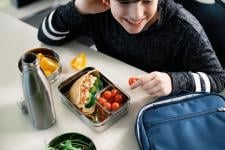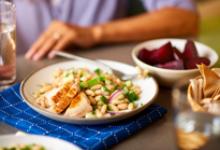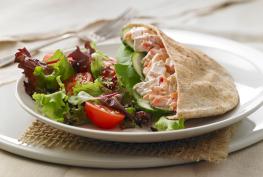The food choices made at school can have an impact on a child’s overall health. Learn how to plan, prepare and choose healthy school meals and snacks that everyone will enjoy.
On this page
Making healthy choices at school matters
Children spend a large portion of their day at school. Making healthy food choices while at school is important because:
- school lunches and snacks:
- provide children with the energy and nutrients they need throughout the day
- are a major source of the essential vitamins and minerals they need to grow and develop
- setting an example may encourage other kids to make healthy choices
How to make healthy choices at school
Remember that there are lots of healthy options. Your food choices can reflect:
- taste
- culture
- budget
Make it part of the meal plan
Making school lunches a part of your meal plan will help you save time and keep you organized.
On the weekend, plan school lunches with your kids for the week ahead. Get their input on foods they like, including:
- vegetables and fruits
- whole grain foods
- protein foods
Stock up on healthy on-the-go snacks you can add to their main meal.
Think about what you will be making for dinner during the week. Some of the leftovers could be used to make quick and easy lunches the next day.
Don’t forget to consider your schedule. Think about whether you can easily prepare items in the morning. If not, wash, chop or pack the night before to make mornings easier. Choose what works best for you.
Involve your kids and get their feedback
Follow the healthy eating recommendation to involve your kids in packing lunches.
Involve your kids in planning and packing their own lunches for school. This can help:
- improve their food skills
- get your kids to try new foods
- make your kids feel part of the process
- decrease the amount of food that comes home uneaten
Organize your kitchen so that lunch making supplies are all in one place. This includes items such as reusable:
- bags
- cutlery
- napkins
- lunch boxes
- food containers
Kids should know which containers are theirs and where they belong. This will help them pack and unpack their lunch boxes.
Kids sometimes complain about having too much food or too little food in their lunch. Sometimes they don’t eat their food at all. If this happens, try asking them about when they eat each item and why they avoid others. It could be that they:
- don’t have enough time to eat
- eat their lunch during snack time
- have trouble opening the packaging of a lunch or snack item
- find the food either too warm or too cold by the time they eat it
Finding the reason they are not eating their lunch can help you pack healthy lunches they will enjoy eating.
Don’t forget to pack water. Include a reusable bottle so they can fill it up throughout the day.
How to make an impact beyond the lunch box
Food plays a big role in the school environment. Food is offered and available in a number of ways, including:
- hot lunches
- class parties
- vending machines
- school fundraisers
- classroom rewards
- seasonal celebrations
Creating a healthy food environment by shifting the focus to healthier foods helps children in many ways. It can:
- increase their access to healthy foods and drinks
- limit their exposure to highly processed foods and drinks
- show them what healthy meals and snacks consist of
- help them use what they learn at school about healthy eating in other environments
Everyone can help improve the school food environment. There are ways to get involved whether you:
- are a student
- work or volunteer at a school
- are a caregiver of school-aged children
To help create healthy habits at your school, you can:
- serve culturally appropriate food for nutrition programs
- plan school fundraisers that don’t involve food. This includes:
- book fairs
- theme days
- dance-a-thons
- celebrate birthdays and special events in the classroom with healthy food choices such as:
- fruit kebabs
- vegetables and dip
- make-your-own yogurt parfaits
- whole grain crackers or pita and dip
- offer non-food items for classroom rewards or prizes. Try:
- pencils
- stickers
- certificates
- extra time for physical activity
- check the nutritional quality of foods and drinks that are available in the vending machines and cafeteria
- work with the service provider to increase the healthy options and decrease less healthy options
- find out if there is a health committee you can join or start one yourself
Make a healthy choice
What you eat on a regular basis matters for your health.
- Choose foods that have little to no added sodium, sugars or saturated fat.
- Compare the nutrition facts table on foods to choose products that are lower in sodium, sugars or saturated fat.






